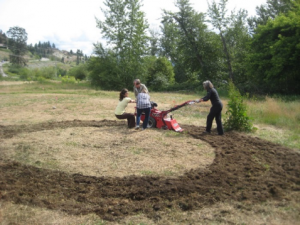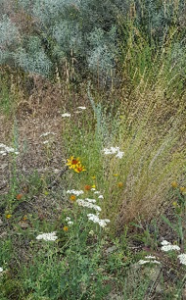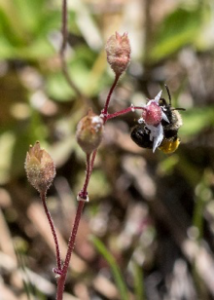A dedicated group of people in Kelowna have met, talked and got their hands dirty to collaborate on creating the Brent’s Grist Mill Pollinator Pasture. Our goal has been to co-generate knowledge for our community to help pollinators and pollinating plants in a dryland ecosystem.
Tilling Circle #2 photo by Emily MacMillen
By bringing together multiple perspectives and collective experience we are creating a pollinator habitat on a 6000 square foot couch-grass invaded piece of land in a dryland climate with no water! Our group of experts come from a variety of fields (from art to gardening to ecology) to form a core thinking and guiding team. We have set up a one-year plan for the development of the pasture.
Creation of Experimental Circles: While the eventual goal is to plant the entire pasture area with native and naturalized seed beneficial to a broad range of pollinators, we have to prepare the highly disturbed land. We decided to experiment with four different ways to prepare the site for planting to see which methods of soil preparation will be most congenial to seeds and plants. Haruko Kagami plotted four 500 square foot circles on the site in the stylized pattern of bumble bee nests and plotted them using satellite photos that indicated similar “green” cover so there would be a baseline consistency of water retention in the soil.
At the end of May 2016 we prepared the circles in the following ways: Circle 1– sheet mulched (with cardboard and mulch- mulch donated by City of Kelowna Waste Management branch and cardboard from several bike shops in town); Circle 2– tilled (with a rototiller donated by Winn Rentals); 2); Circle 3– black plastic cover (lumber wrap donated by Home Hardware in Armstrong); Circle 4– clear plastic cover (donated by Gwen Steele).
This fall the circles were prepped for planting with some soil added (donated by Art Knapps.) Each circle was planted with a similar mix of both seeds (donated by SeedsCo and Wild Blooms) and plants (donated by the Wild Blooms nursery and several grown by OMG and OXA volunteers) as well as plants from a SeedsCo. The Greenery donated meadow sage and lavender. We also intend to nurture some bee-friendly plants that exist on the site already- particularly a kind of catmint, Oregon grape, and yarrow. The main seeds and plants include the following species (colour and bloom time of the flowers appear with the species info), all from Dr. Elle’s list of good bee plants for here:
Pussy-toes (Antennaria dioica ‘Rubra’)- white (May: short plant)
Thread-leaf Fleabane (Erigeron filifolius)- white, blue, pink (May- June)
Slender Hawksbeard (Crepis atribarba)- yellow (late May- July)
Parsnip-Flowered Buckwheat (Eriogonum heracleoides)- white/cream (June- July)
Brown-eyed Susan/ blanketflower (Gaillardia aristata)- yellow/brown (June –September)
Showy Aster (Aster conspicuous)- purple/ pink (June –October)
Yarrow (Achillea millefolium)- white (June and August)
Pearly Everlasting (Anaphalis margaritacea)- white (August)
We will see how the plants and seeds thrive in each circle in the spring and proceed with a large scale meadow-building in the spring of 2017 based on the results of our experiment.
Community Curriculum Team:
Rachel Fleming
Tanis Gieselman
Nancy Holmes
Megan Hunter
Haruko Kagami
Denise Ketler
Maureen Lisle
Lori Mairs
Loretta Muir
Evan Rafuse
Gwen Steele
Rebecca Tyson
Elana Westers
Native flower photos by Nancy Holmes and Robert Lalonde




